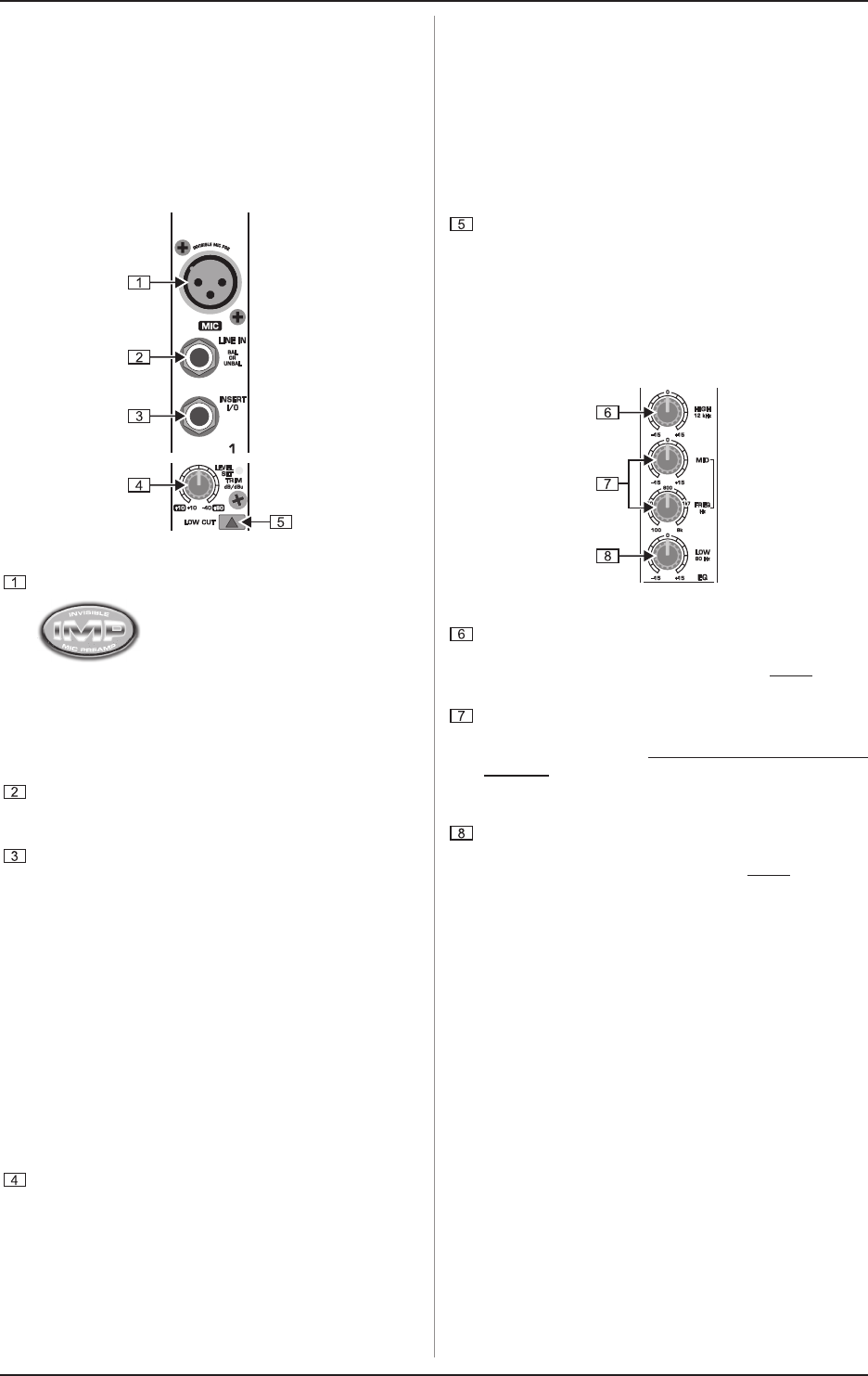
5
EURODESK SL3242FX-PRO/SL2442FX-PRO
2. CONTROL ELEMENTS
2. CONTROL ELEMENTS
This chapter describes the various control elements of your
mixing console. All controls and connections are explained in full
detail.
2.1 Mono input channels
2.1.1 Microphone and line inputs
Fig. 2.1: Connectors and controls of the mic/line inputs
Each mono input channel is equipped with a balanced
microphone input on an XLR connector,
which provides +48 V phantom power
for condenser microphones at the touch
of a button (see rear panel).
+ Be sure to switch off your audio system before you
activate the phantom power supply to prevent
audible switch-on thumps from reaching your
monitor speakers. Please also note the information
given in chapter 2.11 Rear panel.
Each mono input also has a balanced line input on 1/4" TRS
connectors. Of course, these inputs can also be used
with unbalanced plugs (1/4" TS connector).
INSERT I/O connector is used to process a signal with
dynamic processors or equalizers. This insert point is
pre-fader, pre-EQ and pre-aux send.
Unlike reverb and other effects, which are usually added
to the dry signal, dynamic processors process the entire
signal. So, aux send buses are not the best solution here.
Instead, dynamic processors and equalizers are inserted
into the signal path. Once processed, the signal then re-
enters the mixing console at the same point where it left.
Signal interruption only occurs if a plug is inserted into the
corresponding jack (1/4" stereo plug: tip = signal output,
ring = input). All mono input channels are equipped with
insert points. They can also be used as pre-EQ direct
outputs, without signal flow interruption. For this you need
a cable with a 1/4" TS connector on the recorder/effects
processor end, and a bridged stereo 1/4" TRS connector
on the console end (tip and ring interconnected).
The TRIM control adjusts the input gain. Be sure to set this
control fully counter-clockwise before you connect or
disconnect a signal source to or from one of the inputs.
TRIM has a dual scale: the first scale has a gain from +10
to +60 dB for the MIC input.
The second scale has a gain from +10 to -40 dBu for the
line input. For devices with a nomal line output level of
-10 dBV or +4 dBu the setting is as follows: with TRIM fully
counter-clockwise connect the external device and adjust
the output level recommended by the manufacturer. If
available, the output level display of the external device
should read 0 dB with signal peaks. For +4 dBu increase
TRIM, for -10 dBV increase it further. The fine-tuning can
be done with a music signal and the LEVEL SET LED,
which will illuminate when the optimum operating level has
been set.
Mono channels are equipped with a high-slope
LOW CUT filter eliminating unwanted low-frequency
signals, such as floor rumble (18 dB/oct., -3 dB at 80 Hz).
2.1.2 Equalizer
All mono input channels are equipped with a 3-band equalizer.
The maximum boost/cut of the individual bands is 15 dB, in mid
position the EQ is set to neutral.
Fig. 2.2: Equalizer section of input channels
The HI control in the EQ section controls the high frequency
range of the respective channel. It is a shelving-type filter
which can boost or cut all frequencies above a fixed
frequency (12 kHz).
The MID control allows you to raise or lower the mid-range
level. It is a semi-parametric peak filter, which boosts or cuts
the frequency range around a variable mid-range
frequency. Use the FREQ control to select the mid-range
frequency from 100 Hz to 8 kHz. Then use the MID control
to boost or cut the selected frequency range.
The LOW control boosts or cuts the low-frequency range.
Like the HI filter it is a shelving-type filter, which raises or
lowers the level of all frequencies below a specific
frequency (80 Hz).
2.1.3 Aux/FX send buses
Aux sends enable you to take the signals from one or multiple
channels and collect them on one bus. This signal is then present
at one of the aux send jacks, from where it can be routed to an
active monitor speaker or external effects device, for example.
The FX returns are subsequently used as a return bus for the
processed signal.


















